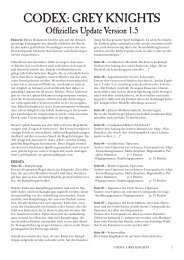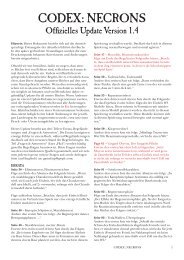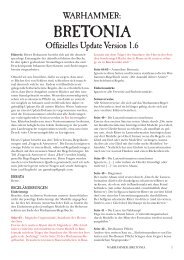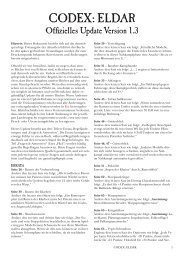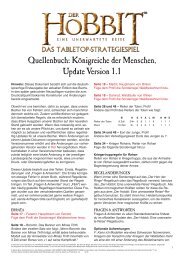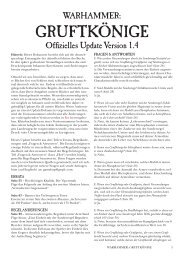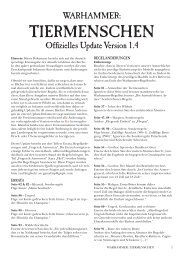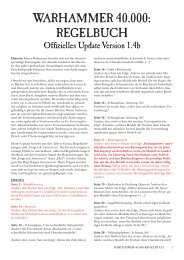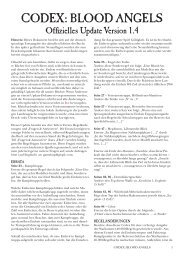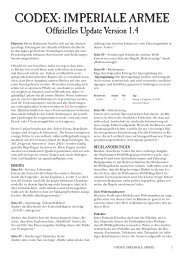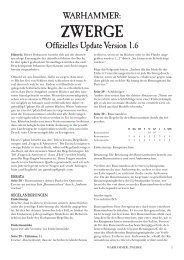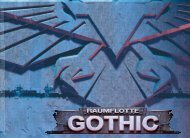Necromunda rulebook - Games Workshop
Necromunda rulebook - Games Workshop
Necromunda rulebook - Games Workshop
You also want an ePaper? Increase the reach of your titles
YUMPU automatically turns print PDFs into web optimized ePapers that Google loves.
AMMO ROLLS<br />
Ammo rolls represent faults in the internal<br />
mechanisms of weapons or ammunition as well as<br />
the possibility of simply running out of ammo. Power<br />
packs can fade or suddenly release a burst of energy<br />
which burns out circuits, shells jam in the loading<br />
mechanism, explode or simply prove dud. No<br />
weapon is absolutely reliable or has an infinite ammo<br />
supply. Some weapons are notoriously fickle.<br />
When you roll to hit a target a dice score of a 6<br />
indicates that your weapon may have malfunctioned<br />
after firing and a D6 Ammo roll is required. Note that<br />
you still hit your target with the roll of a 6 and the<br />
successful shot is worked out as normal. If you are<br />
firing with a sustained fire weapon, ANY ‘to hit’ dice<br />
which scores a 6 will cause an ammo roll.<br />
Some weapons are more reliable than others. This is<br />
reflected by the weapon’s Ammo roll rating as shown<br />
in the Armoury section. Roll a D6. If you roll less than<br />
the number indicated the weapon has malfunctioned<br />
and is useless for the rest of the game. Make a note<br />
on your roster sheet. If you roll the score indicated or<br />
more, then the weapon is alright and you can<br />
continue to use it normally. The examples below give<br />
the Ammo rolls for some common weapons.<br />
Weapon Ammo Roll<br />
Laspistol 2+<br />
Autopistol 4+<br />
Bolt Pistol 6+<br />
Lasgun 2+<br />
Autogun 4+<br />
Boltgun 6+<br />
Flamer 4+<br />
Heavy Stubber 4+<br />
As you can see, laspistols and lasguns are very reliable<br />
weapons, which is why they are favoured by gang<br />
fighters. Bolt pistols and boltguns are more potent<br />
weapons but their complex ammunition means that<br />
they are far more likely to go wrong.<br />
FLAMERS<br />
Some weapons, notably flamers, use a highly volatile<br />
fuel or energy charge and these must make an Ammo<br />
roll every time after they are fired. See the Armoury<br />
section.<br />
GRENADES<br />
Grenades will automatically fail any Ammo test they<br />
are required to make. This means that you have<br />
thrown your last grenade of that type, or that all<br />
further grenades of that type that you have are duds.<br />
OUT OF RANGE<br />
If you shoot and your target is out of range then you<br />
must still make a hit roll to see whether an Ammo roll<br />
is required (ie on the D6 score of a 6).<br />
21<br />
NECROMUNDA<br />
OVERWATCH<br />
The Overwatch rule allows a model to shoot during<br />
the enemy player’s turn. This represents a fighter<br />
taking up position to shoot at an enemy as he<br />
appears in view. The reasoning behind the Overwatch<br />
rule will become apparent once you have played a<br />
few games, so if you are reading this for the first time<br />
we recommend you skip this section for now.<br />
Any model may go onto overwatch at the start of its<br />
turn. A fighter who is down or pinned, or whose<br />
nerve is broken cannot go onto overwatch. You will<br />
find it convenient to place a suitable counter, such as<br />
a coin or stone, by the model to indicate it is on<br />
overwatch.<br />
A model must give up its whole turn to go on<br />
overwatch. The model cannot therefore move or<br />
shoot. The model cannot hide, but may remain<br />
hidden if it started the turn hiding. During the<br />
enemy’s turn the model may shoot at any target as it<br />
presents itself at any time. For example, the model<br />
could shoot before the target moves, after it has<br />
completed its move, or actually while the target is<br />
moving. Overwatch is obviously very useful for<br />
shooting at enemy models as they dash from cover to<br />
cover or as they peek out of hiding to shoot.<br />
Once a model has fired, it ceases to be on overwatch.<br />
The model is no longer on overwatch and is free to<br />
move and shoot normally in its following turn, or go<br />
onto overwatch again if you prefer.<br />
If a model on overwatch does not shoot in the<br />
enemy’s turn then it reverts to normal just as though<br />
it has shot, and the model may move and shoot as<br />
normal. If you wish you may set overwatch again and<br />
give up a further turn as before.<br />
If a model is hit whilst on overwatch it loses its<br />
overwatch status immediately. The same applies if the<br />
model is forced to move for any reason. For example,<br />
if a fighter’s nerve breaks he will be forced to move<br />
and will therefore lose overwatch status.<br />
When you wish to shoot with a model on overwatch<br />
begin by declaring that you are doing so and then<br />
determine the position of the enemy model at the<br />
moment of fire.<br />
Work out the shot as normal, there is a special -1 hit<br />
modifier for shooting at an emerging or disappearing<br />
target whilst on overwatch. This applies when the<br />
target is emerging from a position where he can’t be<br />
seen or is attempting to move to where he can’t be<br />
seen, presenting a fleeting target to the firer.<br />
The same -1 hit modifier is also applied if the target<br />
is charging the overwatcher, representing the<br />
unnerving effect of the enemy’s rapid approach.<br />
Remember that you can fire on overwatch at any time<br />
during the enemy’s turn so you will want to let a<br />
charger get into close range before firing.



